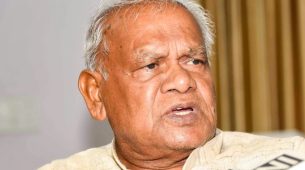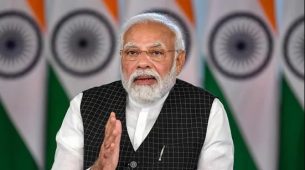'mowgli – Legend Of The Jungle' Review: The Netflix Film Is Dark, Like The Original thenewsminute.com
For most of us growing up in India in the '90s, the animated version of Jungle Book with its chirpy title track was beloved weekend entertainment. Jungle Book, first serialised in magazines in 1893, was a series of short stories by Rudyard Kipling who spent many years of his childhood in India.
Mowgli- Legend of the Jungle, the latest adaptation of Kipling’s classic tale, is a departure from its more child friendly predecessors. Directed by Andy Serkis, the film boasts of a formidable cast of actors who have provided voice and motion capture movements, and is designed to be more faithful to Kipling’s original stories which portrayed the brutality and vulnerability of the jungle and those who lived in it.
Andy Serkis, who is best known for his motion capture work as Gollum in the LOTR trilogy, and the Planet of the Apes revival series, first started work on Mowgli almost seven years ago. After many delays, the Warner Bros. Pictures production was bought by Netflix for distribution and will also see limited theatrical release in America.
The basic premise remains the same. A small human baby is found in the jungle after his parents are killed by the man-eating tiger Sher Khan (Benedict Cumberbatch). A panther, Bagheera (Christian Bale) picks up the little boy and leaves him outside the cave of a wolf family who decide to raise him as their own son, a child they name Mowgli.
Mowgli (Rohan Chand) grows up like his wolf brothers in many ways; running using all four limbs, eating his meat raw, getting lessons from Baloo ( Andy Serkis), hunting for animals and practising for a running challenge that determine his future in jungle. As he gets older, questions about his identity and his obvious physical differences start bothering him.
When Sher Khan returns and poses a threat to his life, Bagheera makes sure Mowgli is sent away to a human settlement at the edge of the forest. But having grown in a jungle, Mowgli can’t really belong amongst his race either. While his constant ‘otherness’ seems like a burden to him initially, can this fluid identity become the need of the hour as man and beast struggle for survival in a rapidly shrinking jungle?
Serkis’s adaptation, written by Callie Kloves, subverts the image of the ‘exotic Indian jungle’ and snake charming brown people by making this tale real and relevant. The movie opens with the death of Mowgli’s human parents, and we first see him covered in their blood. There is no attempt at censoring what life in the jungle is really like – dark, visceral and vulnerable. A telling scene is one where Mowgli swimming in a pond sees Sher Khan approaching and hides underwater. We watch in horror and wonder as the blood from the tiger’s jaw colours the water, and some errant air bubbles escape from Mowgli’s mouth, almost giving him away. You can barely breathe yourself, realising that for Mowgli, any moment can be his last.
Yet the ‘wild’ has its honour code that Mowgli has to learn to live by. While Bagheera and Mowgli’s mother Nisha (Naome Harris) retain their familiar qualities, characters like Baloo and Kaa who were previously portrayed as comic, are refreshingly different in this film. Baloo is more kind-hearted drill sergeant training young wolves, while Kaa (Cate Blanchett) is a wise all-knowing snake whose scales are brilliantly used in a scene as mirrors or screens that offer glimpses of the past and the future.
Though the story is set in the last century, issues of shrinking animal habitats, poaching, and the dangers that man and beast pose to each other are all woven into the narrative. While the film piques our curiosity of how a human child will survive among animals, it also raises questions that people around the world are struggling to answer today. Questions of belonging, identity, and creating homes amongst people who are not necessarily your own.
In many ways Mowgli is a refugee, a child escaping death who finds a home and love. But there are those who never allow him to forget that he is an ‘outsider’ who can never really belong. As the hyena says to him with uncharacteristic depth, “I wake up and believe I’m a tiger, but I will always be a hyena”.
There is also a subplot involving an unwanted albino wolf cub called Bhoot (Louis Ashbourne Serkis) whose story is a poignant parallel to Mowgli’s. Bhoot’s tragic fate serves as timely reminder to the boy that he cannot be truly at home with the humans while they pose a threat to his beloved jungle. Whether or not he will be able to bridge the gap and bring peace to both man and beast is left unanswered, possibly hinting at a sequel in the future.
The beauty and continued interest in The Jungle Book probably comes from the fact that it’s not just a survival of the fittest tale. The central characters are all archetypes; moral or emotional pillars giving the story depth and universal significance. Mowgli- Legend of the Jungle is brought to life by the voices of its talented cast. Matthew Rhys and Frieda Pinto have small roles as the humans who care for Mowgli in the human settlement, but don’t get the opportunity to create much impact.
Special mention to Director of Photography Michael Seresin whose camera unobtrusively become Mowgli’s and our point of view, and Production Designer Gary Freeman, who re-creates Kipling’s jungle perhaps as he originally meant it to be. A labour of love for director Andy Serkis, Mowgli – Legend of the Jungle is definitely worth a watch, albeit not with your young children.







Leave Your Comment